Accessories, Yashica TLR
(Yashica branded or related, designed for TLRs)
Contents
(Scroll down or click on links)
Overview
Dedicated Yashica TLR Accessories
A Note About Yashica Bay 1 Lens Mounts
Accessory Cases, Boxes & Dating
Lens Hoods
Filters
Close-up Lenses
Auxiliary Lenses
Hand Grips (Flash Handles)
Self-timers
Using Cable Release
Accessories Identified in User Manuals etc
Overview
(Note: Many of the accessories identified here are genuinely useful for photography today, but others such as folding reflector flashguns particularly, but probably nearly all flashguns mentioned in this page and the next, are unlikely to be useful at all. This has caused some misconceptions amongst photographer types. The prime purpose of this website is to document the development of Yashica's TLRs and related items, including from other manufacturers, from both historical and collectors' perspectives. That also means matching the accessory's style to the age of the camera for those that worry about such things. That is why there is so much space dedicated to lens hood varieties, for example, when I could just say “Bay 1 and 36 mm, 32 mm and 28.5 mm push-on types” and you would know what I mean. The usefulness of stuff I have added to this page, and the next, is secondary, not a focus.)
Its hard to know what accessories were launched when. The later user manuals only have limited references, mainly to flashguns and filters. The first Yashicaflex A series manuals (end 1954) displayed lens hoods (only A-I/A-II), flashguns and self-timers, but so far, all the evidence suggests that they were generic rather than Yashima/Yashica branded items.
Accessories for the Yashica TLRs have to be placed into context. The first camera was produced by a tiny start-up manufacturer in 1953 for resale by an unrelated marketing company. By the time the Yashica D appeared on the market in 1958, some 23 other models had made appearances, not to mention a lot of trim and feature changes through a continuous improvement approach. There hardly seemed time, or resources, to develop and market an accessory range. Then the TLR market began to crumble, costs became an issue and the focus turned to 35 mm.
Re-branding of a single product for sale by many different companies was common practice in Japan in the 1950s and 60s. The flash handles appear to be a unique Yashica design but the evidence is that certainly some of the earlier exposure meters and possibly all of them, were sourced from other manufacturers and this also applies to the self-timers. Accessory auxiliary lenses were likely to have been sourced from lens maker and Yashica associate, later subsidiary, Tomioka. I have not found evidence of Tomioka making filters, although they could well have, so that remains an unknown. However, as Yashica grew with its 35 mm business in the 1960s and 1970s and considering its fame for introducing electronics into these cameras, it seems highly probable that more accessories were produced in-house. However, this is purely conjecture on my part.
Although there is little hard evidence, my impression of what turns up on auction sites, what I have found generally on the net and what Yashica has mentioned in its documentation is that there were probably no Yashica branded accessories before 1955 and possibly 1956 and that the first items available would probably have been lens hoods. The earliest lens hood that I have seen with branding is in a December 1956 Japanese brochure and it is the only accessory identified. It is a Bay 1 type with typical leather pouch and has the oval logo which first appeared on the 1955 Yashicaflex C and is displayed next to an ad for that model. It is still the only accessory in a similar 1957 brochure. What I believe is almost certainly a 1958 brochure, now lists other items. As well as some accessories for an 8 mm movie camera, the following TLR items are listed:
Lens Hood (Bayonet 30) - 480 Yen
Various Filters for Black & White - 390 Yen
Various Filters for Color - 480 Yen
UV Filter - 450 Yen
Closeup Lens 1 & 2 - 1,800 Yen
(Thanks to Chris Whelan for the translation)
All the items appear to be Bay 1 mount only. None of the three brochures show push-on lens hoods for the advertised models with plain filter mounts.
The first Yashica A, C and LM user manuals from 1956 do say that the cameras accept “sun shades and filters” and that “a complete range of filters and supplementary lenses is available” but is that a general statement to mean that you can go to your photo store and find such accessories to fit your Yashica camera or does that mean that actual Yashica branded items were available? I suspect that Yashica became more interested in accessories as it diversified into the movie and 35 mm camera areas. However, a word of warning; the difference between “never seen” and “confirmed sighting” is precisely a single instance. I had not see any lens hoods for Yashica 44As before I found a pair of “new old stock” items on eBay (one shown further down).
Also note that Yashica was focused on the mass market and volume. There is no evidence of specialised accessories for the much more limited enthusiast market such as panorama heads and some of the other items offered by both Franke & Heidecke and Minolta.
Dedicated Yashica TLR Accessories
A Note About Yashica Bay 1 Lens Mounts
Bay 1 (also known as B30 or 30 mm bayonet) is the smallest size Franke & Heidecke bayonet design for fitting auxiliary items to Rolleicord and Rolleiflex lens mounts (there are also Rollei bayonets size 2 and 3 for their larger glassware but these are not relevant to Yashicas). The Rollei bayonet mounts use an internal bayonet for filters and auxiliary lenses and an external bayonet for lens hoods etc.
A Bay 1 one mount is a Bay 1 mount? Apparently not, or at least not as far as tolerances are concerned. There is also a small number of Yashica Flex S examples with the spring-loaded locating pins and stop pin having a different alignment. More details are at Bay 1 Mounts on the Lenses & Shutters page.
I have not heard of problems with the internal Yashica bayonet and as far as I am aware, all Bay 1 accessories from any maker should fit. It should be noted however, mixing and matching folding metal lens caps between different makes can be troublesome. On the other hand, the external Yashica bayonets may be a fraction over-size in diameter and/or thickness. In Minolta Autocord Autopole, it is noted that there are difficulties fitting the Autopole to Yashicas. There are also forum posts with people having problems fitting Rollei lens hoods and items from some other brands. Correspondent Michel Le Mandat wrote, “I have a Mat and I would point out that you cannot install a Rolleiflex lens hood on Bay 1. I tried with two lens hoods from Rollei, to no avail. The lip of the outer bayonet is slightly too thick.” The size variation is not great, just enough to make it difficult for some items, or even impossible for others without modification.
Accessory Cases, Boxes & Dating
Accessories such as auxiliary lenses and lens hoods were supplied in a leather case. For 66 models, there are both brown and black cases and there are grey cases for coloured hoods (coloured hoods are very rare and I have only seen one grey 66 case and that was for a grey hood). Black accessory cases presumably are from the period that black camera ever ready cases came into being (1965 for the Yashica 24, somewhere around late 1967 for the rest). There are also two styles of black; similar to the brown but in shiny black and a textured black with subtly “modernised” cut to the flap on the lens hood case, I'm guessing from the late Yashica Mat-124G period.
All 44 accessories cases I have seen are grey. As these match the first and more common grey ever-ready cases, it is possible that brown accessories cases exist to match the later 44A and 44LM brown ever-ready cases, however, so far I have found no evidence.
All the filter cases that I have seen are typical circular clear plastic with “YASHICA” across the lid (one shown with yellow filter below), earlier ones in the heavy Serif Western font, late ones in the modern Sans Serif font.
Accessories were generally sold in boxes. The graphic design of the boxes varied with time. Below are some examples, there are others probably not found yet:
Lens Hood Boxes
The first box is for a Yashica 44 grey hood in a grey case found with a boxed 1958 Yashica 44 still with its Japanese user manual - camera and hood were possibly bought at the same time. The second box appears on the cover of a Japanese brochure, which based on featured models, is most likely also from 1958. The third box fits here with its blocky Serif font, possibly from early 1960s on. The Sans Serif font makes the fourth box fairly modern, possibly from the late 1960s, but the leather case inside is still brown leather and the hood itself still uses the Serif font. The last box is found with the very last lens hoods with black textured cases, probably from after the Yashica Mat-124G release and getting close to 1980.
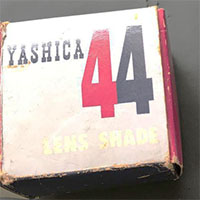
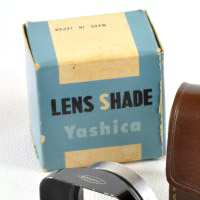
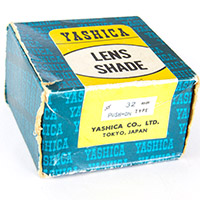
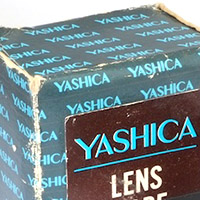
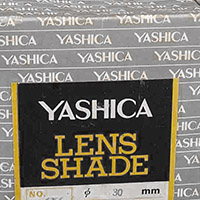
(Images 1, 2, 4 and 5 detail from larger web images)
Note, boxes 1, 2, 4 and 5 are for Bay 1 hoods, box 3 is for a 32 mm slip-on type but graphics are the same for both types.
Mystery Box
This box from Tom Heckhaus' collection contains a Bay 1 lens hood which fits nicely but the box is far too small to include the leather case with which hoods were normally sold with. Also, unlike all other boxes, there is no label which would make inventory management rather difficult. Tom tells me that he bought it like that “many years ago” at a camera show in New Jersey which might suggest that it was a promotional item of some sort. I have also discussed it with contributor Chris Whelan and all we are reasonably certain of is that it matches camera presentation boxes from around 1964, maybe a little bit later for TLRs. Tom's profile suggests that he wouldn't have had a use for a Bay 1 lens hood until at least 1970 so it's all a bit of a mystery:
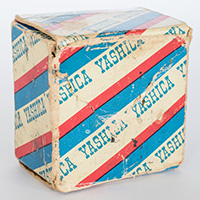
Filter Boxes
The first box is definitely the earliest of those below. The narrow “Y” in a circle first appeared on coloured models as a hood logo in 1958. In that guise, it was white on a gold background. In 1959, it first appeared on a blue background on 44 models, however, it was not universally adopted on all models until the beginning of 1960. I suspect it wouldn't have appeared on accessory boxes until it was on all camera models. In fact the precursor of this box with same colours and style but earlier font style and without the “Y” appears on the same 1958 brochure as the first hood box above. I'm not absolutely certain about the correct order of boxes 2 and 3. Filters found in the first three boxes have the first style with silver rim, black retainer and image of “YASHICA” in the glass (details further below). The fourth box, already with Sans Serif font, is for the late 1960s all silver mount. The fifth box is for the last type with all black mount.
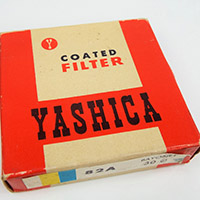
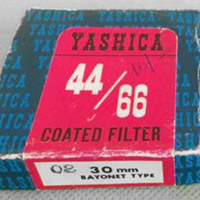
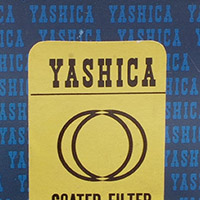
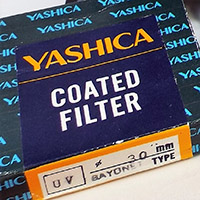
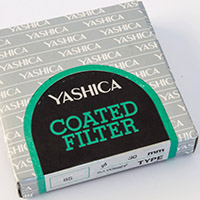
(Images 1 & 4 courtesy of Chris Whelan, images 2 & 3, detail from larger web images)
Close-up Lens Boxes
The left close-up lens box below is for a 36 mm push-on set (I have a photo of another in the same style for Bay 1). The last camera model with that bezel size was the Yashica B and both the graphic style and the camera model suggest the 1958 to 1961 period but the set's leather case with the “Yashica” in the oval logo may bring the end date back to 1960. It's a bigger heavy duty box with separate lid and the case and lens set are laid out side by side (see also Close-up Lenses). The right box is for the last type Bay 1 mount close-up lens and complements the similar late lens hood and filter boxes and is almost identical (except for size) to the last telephoto and wide angle lens boxes (not shown). It's a smaller lightweight box with the lens set stored inside its leather case:
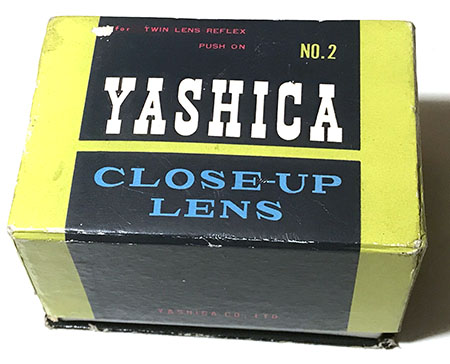
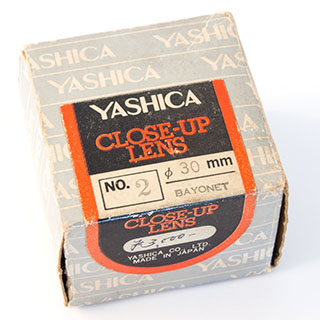
(Left image is courtesy of Ondřej Toms)
Hand Grip Boxes
Earlier and later (probably late 1960s) boxes for the 66 hand grip:
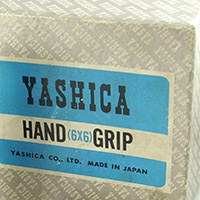
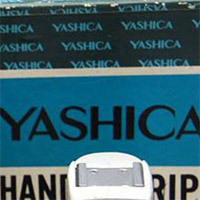 (Detail from larger web images)
(Detail from larger web images)
Lens Hoods
Referred to as “lens hoods” in both the very early Yashicaflex A “directions” and the latest Yashica Mat-124G “instruction booklet”, for much of the in between time, they were referred to as “sunshades” or “lens shades”.
These come in Bay 1 and push-on fittings. For 66 models, at least some Bay 1 types were originally supplied in an orangey brown case, occasionally found with the Yashicaflex C on Japanese sites, then brown and from the mid-1960s, black cases, first in shiny black and then in a textured finish. “Yashica” appears in an oval, in heavy serif block letters or in plain letters corresponding to the camera trim at the time the hoods were produced. The later plain text ones are found in the black cases. The earliest 32 mm push-on hoods have the “Yashica” oval logo and the later type have the heavy serif block letters from the late '50s and early '60s. The cases for both types are brown with the logo/name matching the hood. The only hoods I have seen for 44 series models (both Bay 1 and push-on) are in grey cases and have “Yashica” in the oval.
It appears that 66 Bay 1 lens hoods intended for the Yashica D were available in colours to match the metalwork, i.e. black, grey, brown and perhaps light brown. A Japanese website has a photo of the first three together, all with the oval logos of the Yashica D colour period from 1958 to 1960. All except the black (obviously intended for all Bay 1 models) are extremely rare. I have seen two other grey ones. Most found 44 hoods are grey, however there does appear to be an original black version with the Yashica oval and the correct 44 bayonet orientation found with a black Yashica 44 - it certainly looks black in good lighting. Its case is grey, matching the camera case. Another black one has been found with a black 44LM. The Pastel Blue hood below (two photos) was acquired with the Charcoal 44LM by contributor Leigh Harris. The first Rose Brown one below was for sale with a black Yashica 44LM but the one on the far right was found with a colour matched Yashica 44:
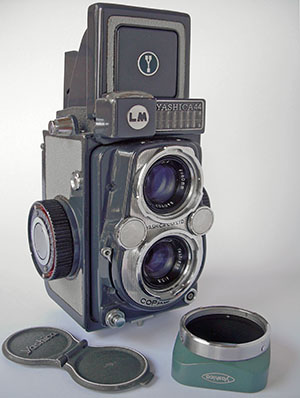
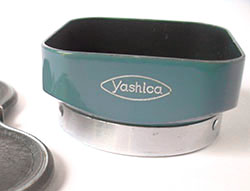
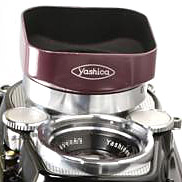
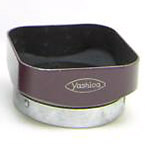
(Images 1 and 2 courtesy of Leigh Harris, images 3 and 4 detail from larger web images)
Presumably, all the other four 44 colours were available as well.
The Yashica A and all other Yashica 66 cameras with the basic plain filter mounts plus the Yashicaflex A-III use 32 mm hoods. Apart from the Yashicaflex A-III, cameras with plain filter mounts but with a panel around the lenses somewhat like Bay 1 models, have larger 36 mm diameter mounts. These are the Yashicaflex A2 and A (new model) and the Yashica B. The Yashica 44A has a smaller 28.5 mm mount. They are all very rare and hard to find. I don't have any documentation for the 36 mm types and I have seen no matching Yashica hoods for sale. 32 mm push-on hoods are referred to in user manuals and brochures but I have only seen four for sale. Two were the early type with “Yashica” in the oval, one with a brown case (hood featured below), the other without, and the other two were similar but with the later “Yashica” in heavy serif block letters and matching brown cases (one of these is also featured below). The 44A is one of a pair offered together and I have seen one other only.
Branded Bay 1 hoods found are square shaped, branded push-on hoods are circular and so far, only black have been found.
Earliest Push-on Types (Non-Yashica Branded)
The earliest user manual featuring lens hoods I have seen so far is the English language Yashicaflex A manual for the A-I and A-II models still featuring the earliest trim including Y.S.K. shutter. Lens hoods do not appear in the Yashicaflex S or AS manuals. The Yashicaflex A user manual example below left is a silver finished square type (somewhat like the Bay 1 types) with what looks like a three character name followed by two other characters which are probably numbers.
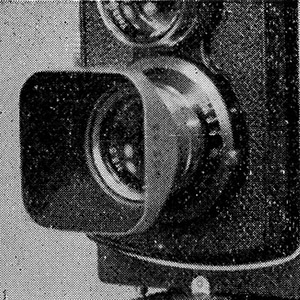
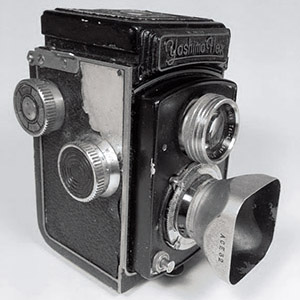
(Right image courtesy of Sandu Baciu)
In my database are several similar hoods found with cameras as early as the Pigeonflex already. On the right is a Yashima Flex shown with hood turned 180 degrees relative to the example in the Yashicaflex A manual. These have the name “ACE 32” and I am pretty certain that they are the same as in the Yashicaflex A user manual.
The slightly later Japanese language Yashima “Yashicaflex Photography” guide was first printed on 5 August 1955 and featured a model A-II with the new body already. The lens hood in this document is silver but circular like the Yashica A type further down. No name is discernible. In my database there are several circular lens hood types found with A-I and A-II examples. One has “ACE 28.5” on the side. It is likely that Yashica had simply picked an unrelated brand of lens hood to demonstrate hood use, somewhat similar to its choice of Minicam flashguns to demonstrate flash use (discussed further below and on the next page).
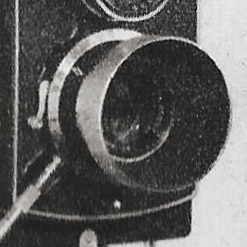
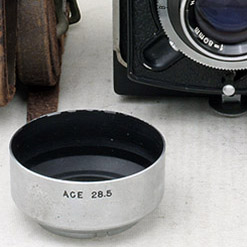
(Left document image courtesy of Chris Whelan, right detail from larger web image)
The ACE number “32” clearly refers to the filter mount diameter and so does “28.5”, but no, only a 32 mm size will fit the early 66 models. Mystery solved when I found another for sale complete with 28.5 mm to 32 mm step-up ring, not visible in the photo above. I have since acquired two circular “ACE 32” lens hoods. The first one came with the earliest type Yashimaflex but is shown here fitted to a Yashicaflex A-II with Y.S.K. shutter and the second, the last image in the group, came with the earliest Pigeonflex found so far and includes the leather case with internal sleeve for the filter:
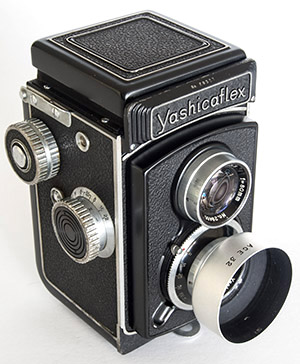
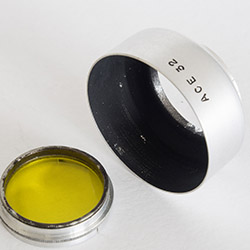
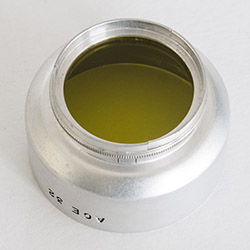
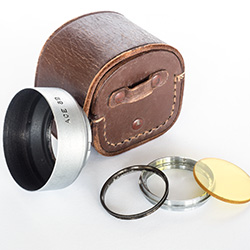
The hoods can be used by themselves or in conjunction with the yellow filter with stepped mount the front of which fits inside the hood with the rear part fitting over the lens mount. With or without adaptor, the mount size remains 32 mm.
It should be noted that the connection to the ACE circular type lens hoods is circumstantial only. Other early cameras have been found with similar “Tubasa” push-on hoods and no doubt that there were many other brands. The important point from all this is that there were probably no Yashica branded lens hoods until at least 1955 and perhaps later.
Bay 1 66 First Yashica Branded Type Examples
The construction of all the Bay 1 lens hoods appear similar except that the earliest types carried the rounded part further forward. The first one on the left below was advertised with a late, probably 1956, Yashicaflex C on a Japanese website. Yashicaflex C camera ever-ready cases are found in both an orangey brown and a darker brown (I'm not sure if one is earlier or both were available at the same time) and I have seen both colours for the early hood cases, the one below being the orangey brown type. Yashicaflex Cs are probably the most common of the Yashima/Yashica TLRs to turn up on Japanese auction sites and occasionally, they have the matching hood, but these hoods are rare in the west. The example on the right is a scan from the December 1956 Japanese brochure referred to in the Overview above. Note, its case looks light in tone, perhaps similar to the first example, but I haven't found the curved cut of the flap taper on any that I have seen for sale (all, except the “modernised” very last textured black type, are cut like the first example):
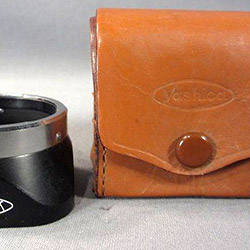
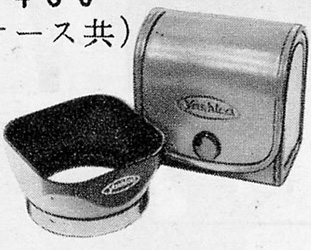
(Left, detail from larger web image)
This is my example bought from Japan, shown fitted to an early Yashicaflex C:
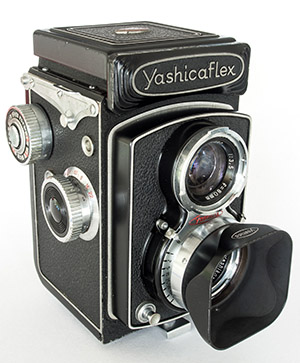
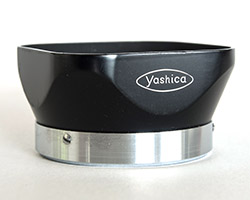
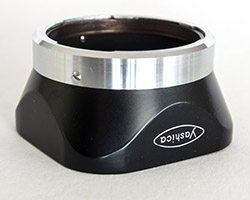
Below is a comparison with the last type lens hood but the shape and screw secured chrome mount had already changed to the squarer shape with riveted mount by the late 1950s:
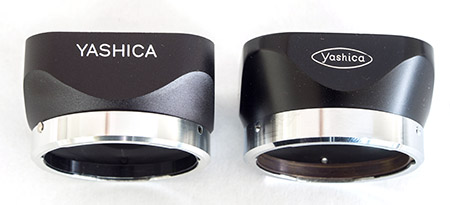
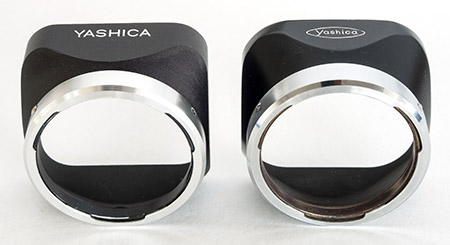
The original Japanese Yashica-Mat user manual still displays the early type hood:

Bay 1 66 Late 1950s Type Example
This example belongs to correspondent Guus Hommes whose grandfather bought his Yashica LM in 1958 or 1959. The lens hood and case look to be from the same period. Note how the shape is more like later hoods already:
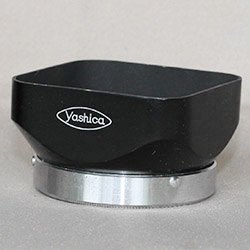
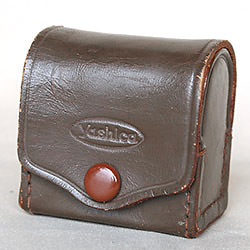 (Images courtesy of Guus Hommes)
(Images courtesy of Guus Hommes)
Bay 1 66 Early to Mid-1960s Type Example
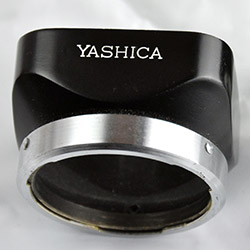 (Image courtesy of Göran Årelind)
(Image courtesy of Göran Årelind)
Most probably, was supplied in a matching dark brown leather case similar to the brown case above and the late 32 mm push-on case further below with the same style heavy Serif “Yashica” font.
Bay 1 66 Late Type Example
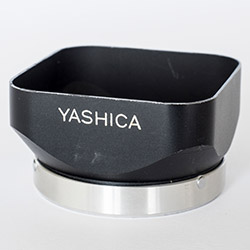
From the collection of Tom Heckhaus, late type “Yashica” from 1966 or later. Still satin-black paint. The earlier black cases were glossier, with a smoother grain texture and “classic” cut to the flap taper much like the earlier brown case above and the 32 mm cases below.
Bay 1 66 Last Type Example
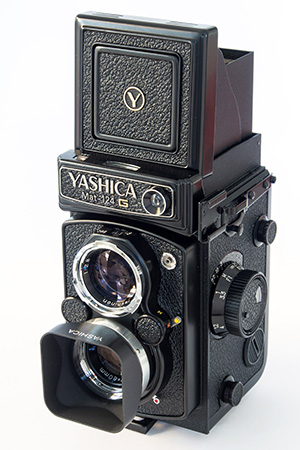
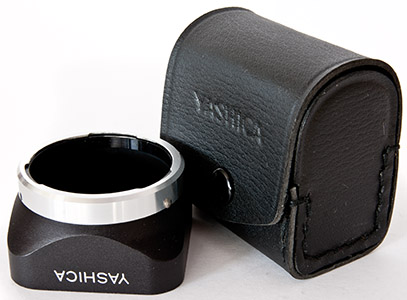
This is the last style lens hood and case, I'd say at least 1970s, or perhaps even later to match the last style Yashica Mat-124G case from about 1981 onward. The hood has a new lightly textured finish and the case has a pronounced leather grain with straighter cut to the flap.
Bay 1 44 Series Example
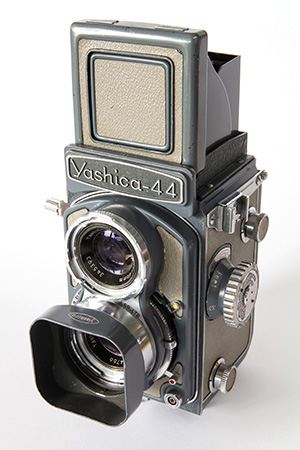
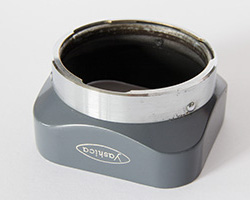
Although it looks darker in the left photograph, the colour of this hood matches the Silver Gray Yashica 44. The 44 hood below is a similar colour, Göran assures me that it is lighter than Charcoal Grey.
Bay 1 - 66 & 44 Series Comparison
Although Bay 1, the Yashica 44 and Yashica 44LM have their own hoods. Bay 1 has inside and outside mounts but both original Yashica 66 and 44 hoods use the outside mounts (some accessory hoods use the inside mounts which then cause problems with filters). Pictured below is a black 66 Bay 1 hood and a grey 44 Bay 1 hood:
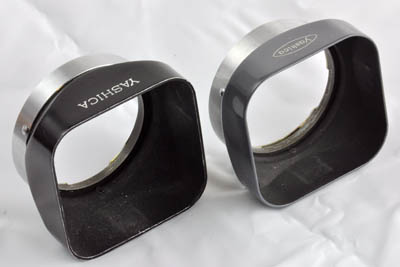
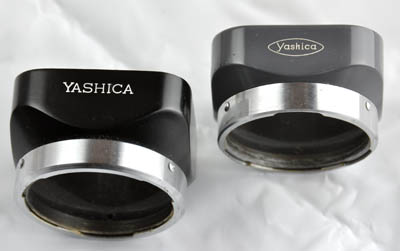
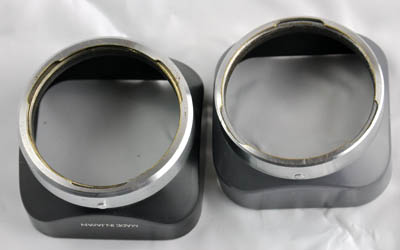
(Images courtesy of Göran Årelind)
The following measurements are also courtesy of Göran Årelind. The inner diameter of the circular mount is 37 mm on both. The outer diameter is 44 mm on the 66 model and 42 mm on the grey 44. The rim thickness is approximately 3.3 mm and 2.2 mm respectively. The gap between lens filter mounts is 4 mm on 66 cameras and 2.5mm on 44 cameras and therefore the larger physical size of the 66 hood mount is what stops it being used on 44 cameras. In practice, the 44 hood will fit 66 cameras but I am not sure if there are any vignetting problems.
The 66 hood measures 55 mm diagonally across, corner to corner, and 44 mm side to side. The 44 hood measurements are 52.5 mm and 43 mm respectively. Whilst these measurements may suggest a problem, the smaller size could be offset by being less deep; 18 mm for the 66 hood and 16 mm for the 44 hood.
Note that the Bay 1 tabs on the 44 cameras are rotated 180 degrees from the 66 cameras but this has no practical consequences.
32 mm Push-on Early Type Example (Yashica A type)
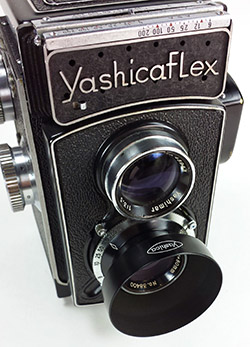
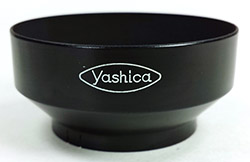
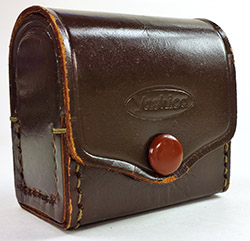
(Images courtesy of Chris Whelan)
Although this logo first appeared on the 1955 Yashicaflex model C, brochures from the period only display the model C's Bay 1 hood so I suspect that this is from a little later, perhaps from 1956 and possibly coinciding with the release of the Yashica A (this hood was for sale in the US). Of course, it fits all 32 mm push-on type filter mounts including the Yashicaflex models A-I, A-II and AS-II which were all probably still in production, as perhaps was the Yashicaflex A-III. Here it is shown fitted to an early Yashicaflex model AS-II.
32 mm Push-on Late Type Example (Yashica A type)
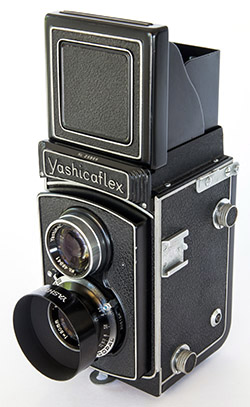
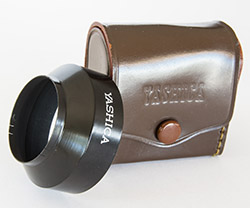
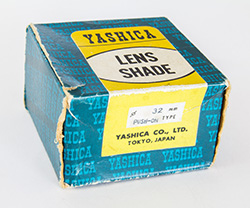
By the time this lens hood was made, the only model left with 32 mm plain filter mounts was the Yashica A (and perhaps its Japanese twin, the Yashica A III). Shown here fitted to a late 1954, early 1955 Yashicaflex A-II. Although the style of the “Yashica” name is out of character, this is only a consideration for collectors and there is no reason why it can't be used on a Pigeonflex, for example.
28.5 mm Push-on Example (Yashica 44A type)
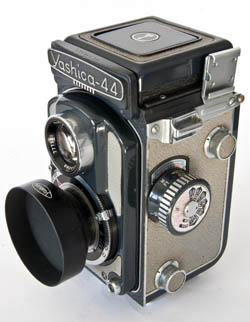
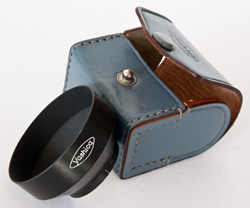
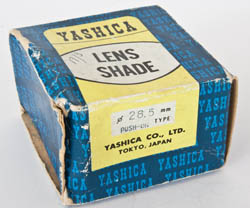
Filters
Below are examples of Yashica branded Bay 1 and 32 mm (Yashicaflex A series and earlier and Yashica A and Rookie) and 28.5 mm (Yashica 44A) push-on filters. Presumably, Yashica push-on filters were available for 36 mm as well but I have seen no examples. The Yashica E uses standard 52 mm screw in filters which cover the selenium cell. The first advertising of Yashica filters I have seen is from 1958.
The Bay 1 filters use the inside mount so that lens hoods using the outside mount can be used simultaneously. There are three rim variations found; silver with black retainer similar in appearance to the yellow and orange push-on filters and Bay 1 filters below, all-silver finished and the last ones (certainly from the 1970s on) are finished in black. The all-silver ones appear in some later manuals and brochures together with the all-black version and the script on the silver example I have matches the black, so I would say late 1960s to early 1970s. Some of the silver with black retainer have an earlier style font to others which are otherwise the same. I presume that these are the first type and probably date from the late 1950s.
The following two filters are push-on types (the only examples I have seen photos of, therefore rare); the yellow on the left is a 32 mm 66 type and the orange on the right is 28.5mm for a Yashica 44A (I think that the yellow has the earlier “Yashica” style on the rim just like the boxed Bay 1 example directly below, i.e., these are the earliest type filters found thus far):
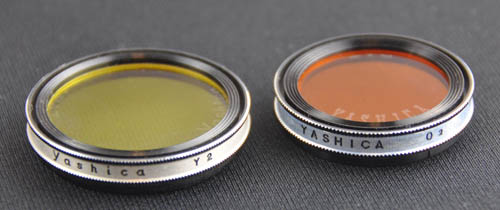
(Image courtesy of Göran Årelind)
Early Bay 1 82A filter, similar vintage to the yellow 32 mm type above:
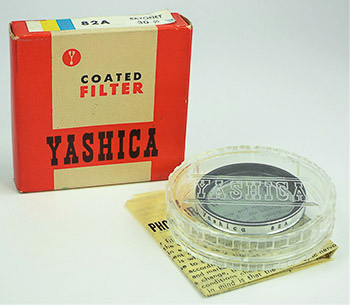 (Image courtesy of Chris Whelan)
(Image courtesy of Chris Whelan)
The odd thing about all these silver with black retainer filters is that the “Yashica” and other text appears as a permanent feature. Some, presumably 1950s or thereabouts, Nikon filters are similar and maybe the practice was more common. The text is not visible from directly ahead, but even at slight angles, it is and it is definitely not an easily removable film or similar (although Chris Whelan has managed to remove most of the text on another example by over-vigorous cleaning). Here are two of my similar style Bay 1 types with the same text and the same Y2 yellow in its case with the text not visible:
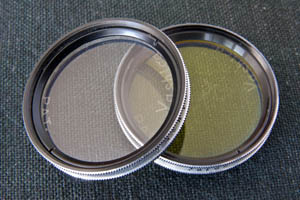
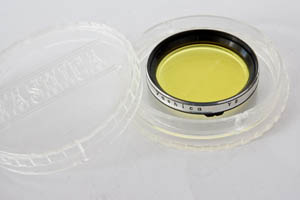
A late 1960s/early 1970s all silver rimmed red Bay 1 filter, neither these nor the subsequent all black type exhibit the “Yashica” text:
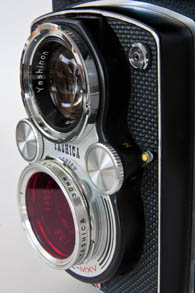
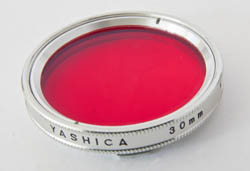
Last type black rimmed UV, Blue, 1A Skylight, 82A and 85 examples, first image boxed and second image unboxed and uncased:
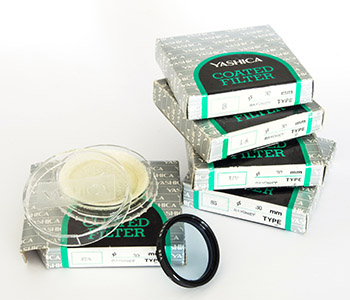
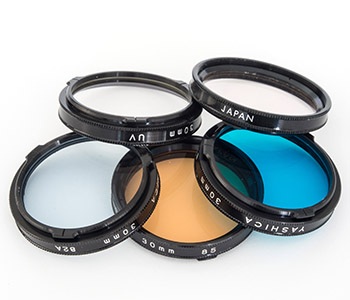
This is the information sheet that came with the first type yellow and orange push-on filters above (it specifically refers to B&W filters and advises that Yashica filters for colour film are available separately):
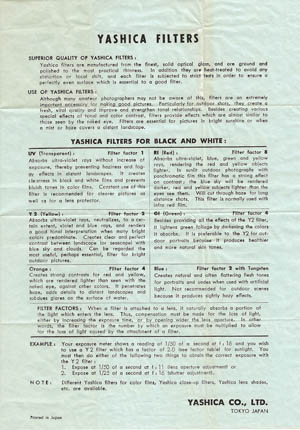 (Document scan
courtesy of Göran Årelind)
(Document scan
courtesy of Göran Årelind)
(Click on information sheet for larger view)
Below is advice for colour photography found with the similar vintage boxed 82A filter above:
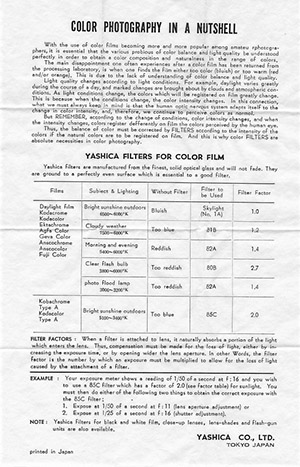 (Document scan courtesy of Chris Whelan)
(Document scan courtesy of Chris Whelan)
(Click on information sheet for larger view)
The multilingual information sheet below (only English panel displayed) for both colour and B & W filters was found in each of the above boxes for the late black rimmed filters:
.jpg) (Click on information sheet for larger view)
(Click on information sheet for larger view)
Some later camera user manuals mention UV, ND2, Y2, O2, R1, and G1 for B&W film and 1A, 80B, 81B, 82A and 85 for colour film whilst the information sheets between them also add B (blue) to B&W for portraits, FLY-D to colour to correct for artificial light and ND4 and Polarizing for both types of film. However, filters for colour are generally mentioned less and are harder to find. I don't know that I have seen any Yashica Polarizing or FLY-D filters.
Close-up Lenses
According to a Yashica US brochure, most probably from 1959 (see the period 1958-1965 further down), close-up lenses were available in both “slip-on” and “bayonet” fittings. A photo of a 32 mm slip-on type set appears in the 1959 Yashica A III user manual and they are also listed in the Complete Yashica Price List (USA, effective 1 March 1969). Below is a 28.5 mm slip-on No. 1 set for the Yashica 44A, the only one that I have ever seen. Taking lens and viewing lens on the left and stacked together on the right ready for storage in the set's leather case (as for the Bay 1 types below):
.jpg)
.jpg)
(Detail from larger web images)
Correspondent Ondřej Toms has provided photos of his boxed close-up No. 2 “push on” set (“slip-on” and “push on” are just semantics for the same thing). Oddly, the lens bezel diameter is not mentioned, possibly because the same box may have been used for 28.5 mm (Yashica 44A) 32 mm (e.g. Yashica A) and 36 mm (e.g. Yashica B) sets. This close-up set fits 36 mm bezels and like the 28.5 mm version above, the only set I have seen in this size. With close-up lenses possibly first arriving around 1958 and the last of the 36mm bezel models, the Yashica B, being made from 1958 to 1961, the box graphics also suggest a similar period, however, the “Yashica” in the oval logo on the leather case probably brings that back to 1960 or earlier, so perhaps 1958 to 1960:
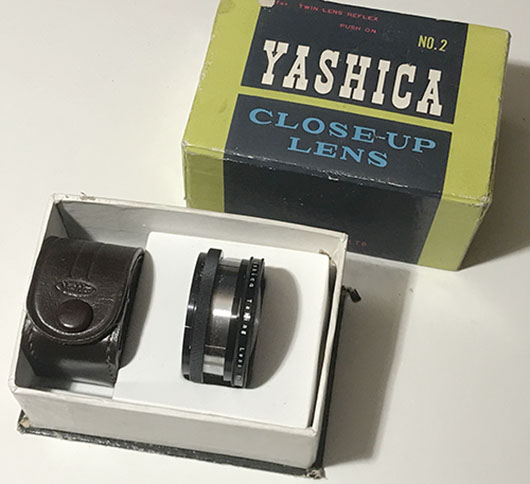
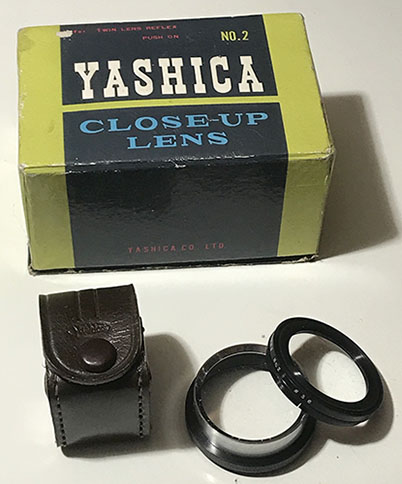
Larger view of details:
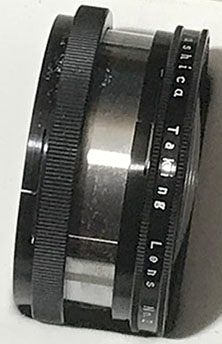
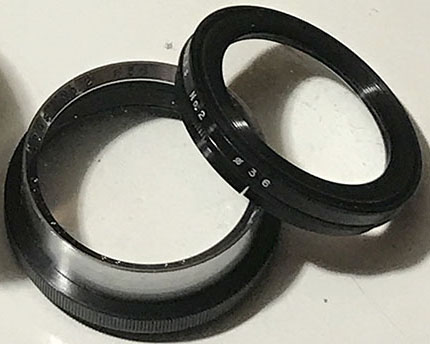
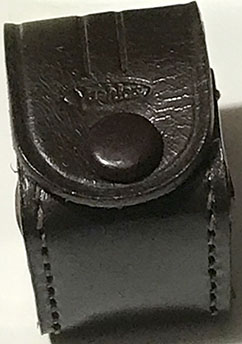
(Images courtesy of Ondřej Toms)
Left image below is the “push on” description on the above box and on the right, “bayonet mount” on a similar vintage No. 1 set box:

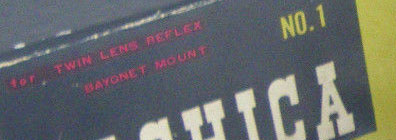
(Left image courtesy of Ondřej Toms, right is detail from larger web image)
With Yashica close-up lenses, there are two sets for each mount, each with auxiliary viewing lens and taking lens. They are referred to as “No. 1” and “No. 2”, the second one being stronger. The instruction sheet below is for Bay 1 fittings and indicates that they are suitable for both 66 and 44 Cameras. This instruction sheet has the narrow “Y” logo adopted on all models from the beginning of 1960. Apart from font size, there is also an identical post-1965 version with the wide “Y” logo.
.jpg) (Document image
courtesy of Göran Årelind)
(Document image
courtesy of Göran Årelind)
(Click on information sheet for larger view)
This is the focus distance table at the bottom of both instruction sheets:
Set |
No. 1 |
No. 2 |
For 6x6 Camera |
from 65 to 40 cms. |
from 45 to 35 cms. |
For 4x4 Camera |
from 57 to 43 cms. |
from 42 to 35 cms. |
The Yashica Mat-124G brochure further down the page varies these distances:
Set |
No. 1 |
No. 2 |
Yashica Mat-124G |
from 61 to 44 cms. |
from 45 to 36 cms. |
Were the distances revised from experience or the distances different in different versions? There is a physical difference between early and late versions - see below.
An important point to note is that the viewing lens, the larger of the two, because of the built-in parallax correction, has a red mark to indicate correct orientation. The chrome lens below has a small red circle and the following black lenses have a red dot (visible in the third photo). Göran Årelind has pointed out that the viewing lenses must be mounted so these marks end up on top, otherwise the parallax correction will be in the wrong direction. This is not mentioned in the instruction leaflet that I have.
Below is an earlier No. 2 Bay 1 set with typical all black taking lens and viewing lens with a chrome bezel. Its case has the second earliest type “Yashica” name on the case (earliest is the oval logo type on the 36 mm case above), probably from no earlier than 1960:
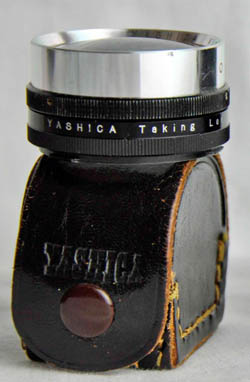
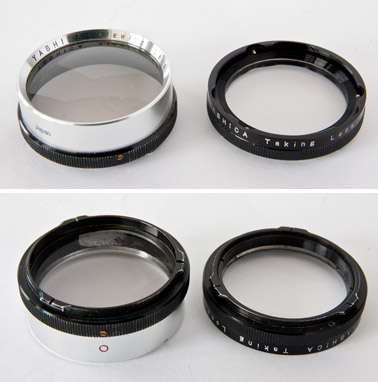
(Left image courtesy of Göran Årelind)
Note that the taking lens has a Bay 1 receptacle on the front so that the viewing lens is mounted to it for storage. Of course, the receptacle also accepts Bay 1 filters.
There is a Japanese brochure featuring the Yashica Mat-124G and a pair of close-up kits with the chrome bezels still. The two all black No. 1 and No. 2 sets below are the most recent and common type:
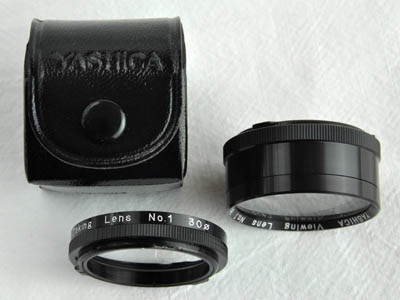
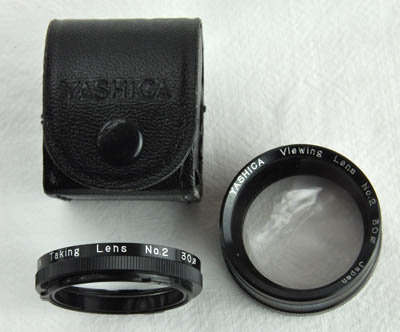
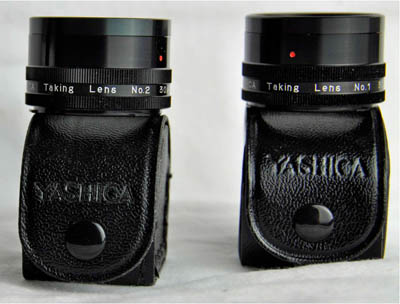
(Images courtesy of Göran Årelind)
The black viewing lens is of a slightly different construction and deeper than the earlier ones. There maybe an improvement of some sort, noting the slight widening of the focusing range (insignificant for the No. 2) referred to in the instructions above, but being cynical, a construction change to the viewing lens this late in life could mean a cost cutting measure. Early (left) and late (right, same type as above) No. 2 close-up lenses:
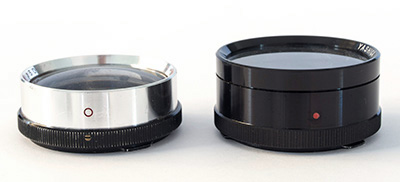

Note that the taking lenses look virtually identical except for a minor difference in letter spacing. Below is the complete late No. 2 kit, also shown mounted:
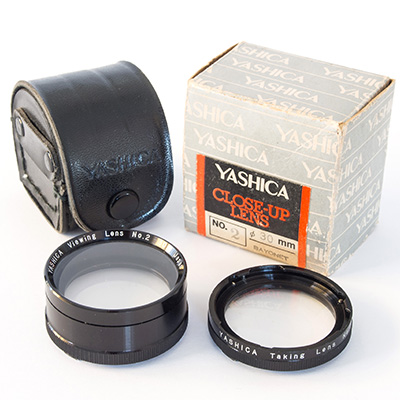
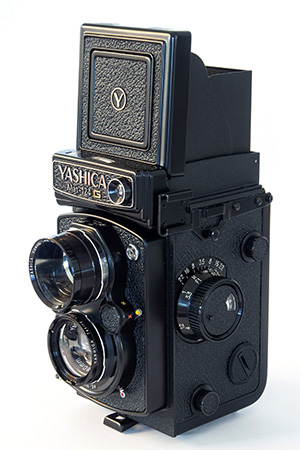
Auxiliary Lenses
For the 66 cameras with Bay 1 filter mounts, Yashica offered both a wide angle and telephoto set comprising an auxiliary viewing lens and taking lens. The earliest type, already branded “Yashinon”, didn't have the later silver band and the taking lens body tapered in a a cone shape for both wide angle and telephoto types. These are fairly rare. They have brown elliptical leather cases with the auxiliary taking lens and viewing lens sitting next to each other. Both viewing and taking lenses have serial numbers, later types don't. Shown below is the wide angle set in its case, both wide angle and telephoto sets and the telephoto set attached to a similar vintage Yashica 635:
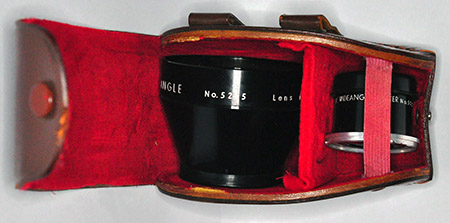
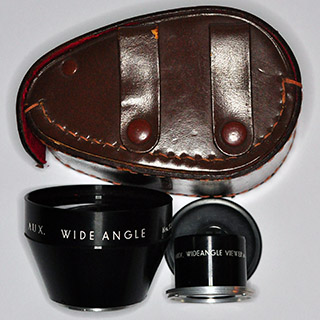
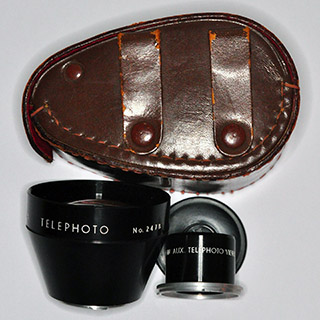
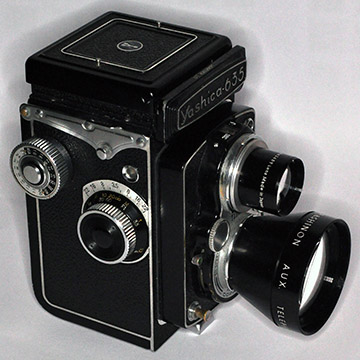
(Images courtesy of James Eva)
I am guessing that the first type arrived in the early 1960s. Up to about at least 1964, UK importer Photax didn't include the auxiliary lenses in its usually complete accessories listings. The only marketing reference I have seen for this version is in this circa 1964 Yashica brochure (scanned courtesy of Gordon Brown).
The next two types are very similar but I think that the type with the narrow silver band came first - the lens caps seem to use the earlier font whereas the type with the wide silver band can be found with both:
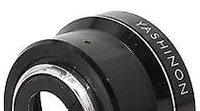 (Detail from larger web image)
(Detail from larger web image)
Both later type sets were supplied stacked in a cylindrical style case which was brown initially and then changed to black:
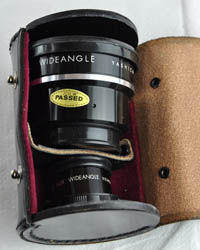
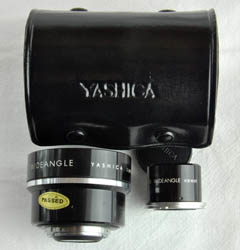

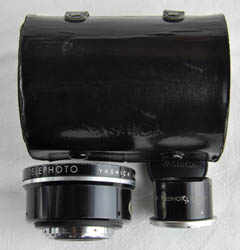
(Images courtesy of Göran Årelind)
Wide angle set fitted to a Yashica Mat-124G:
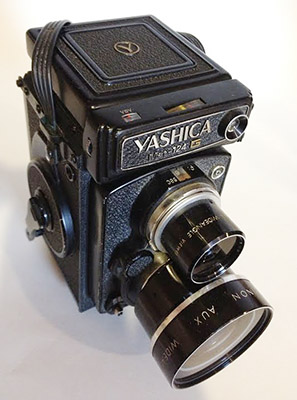 (Image courtesy of Sandu Baciu)
(Image courtesy of Sandu Baciu)
The taking lens of all types is fitted with front and rear lens caps, the viewing lens is fitted with a front lens cap only. The examples below belong to the third style telephoto lenses with a black leather cylindrical case. Earlier lens caps have the “Yashica” name in the earlier “Western” block style and the “Y” in the circle is the narrow type instead of wide type:
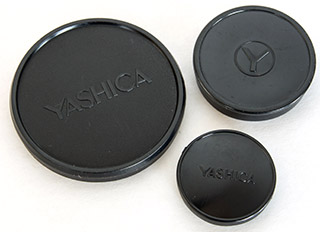
According to an earlier user manual featuring a Yashica 635 with narrow “Y” hood logo (1959 to 1965), the telephoto auxiliary lens increases focal length by 50% to 112.8 mm, or 1.5 times magnification and the wide angle auxiliary lens decreases focal length by 25% to 58.4 mm, or .75 times magnification. (In the manual’s terms; “The picture area is increased by about 75%.”)
There is also a later, more detailed manual featuring the Yashica Mat 124G. It provides the following additional important advice:
- Use of apertures from f/5.6 to f/11 is recommended and that vignetting may occur at f/16 or f/22.
- With the telephoto lens, the actual distance is 2 times the camera distance scale reading. Infinity is still infinity.
- With the wide angle lens, the actual distance is 1/2 the camera distance scale reading. Infinity is still infinity.
 (Click on instruction for larger 2 page PDF with reverse side in Japanese)
(Click on instruction for larger 2 page PDF with reverse side in Japanese)
Having said all that, the reputation of these lenses is not great (I wonder if they have been used in accordance with the recommendations?) but then that is probably true of most, if not all, auxiliary lenses. There is the inevitable slight loss of sharpness, although not much by all accounts, however the major issue is vignetting which continues at wider apertures than suggested by Yashica and never really goes away. No doubt the best results are obtained with “zooming with your feet” but if you are after a particular look, perhaps portrait use, then I am sure that these lenses in the right hands and with regard to their limitations, can be made to perform quite adequately.
Anyone with a Yashica 635 wondering about using the auxiliary lenses with the 35 mm kit should consider Daniel Deary's review originally posted on photo.net forums (link removed, page no longer exists). In brief, he found that the 35 mm format uses the sharpest central areas of both camera and auxiliary lenses but the auxiliary lenses still result in some loss of sharpness. However, his biggest complaint is the inconvenience of shooting in landscape format - this may or may not be a factor for your style of shooting.
Can the Yashica auxiliary lenses be used on the 44 models? In my database are two 44LMs with the telephoto set mounted. There doesn't appear to be much clearance and it looks like the viewfinder lens has to be mounted first:
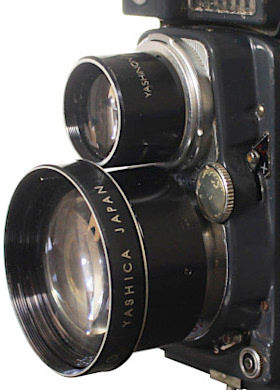 (Web image)
(Web image)
Do they work? Presumably, but I have no practical knowledge of using them. I have seen no relevant Yashica documentation which mentions the 44 cameras. The instructions for the 124G era state the lenses “are designed for use exclusively with Yashica twin-lens reflex cameras”. That's at least 5 or 6 years after the last 44LM camera was produced and sounds a bit restrictive about suitability, inferring perhaps that they are designed solely for Yashica 66 models. However a circa 1964 Yashica brochure (linked above and on the Brochures page) features a number off 66 models and the 44LM and also the first versions of the auxiliary lenses (wide angle set mounted on a Yashica Mat-EM) with the comment that the lenses “can be used with all twin-lens reflex camera with bayonet mount”. Interpret that as you will.
There are also grey lens sets with light grey lens caps and elliptical leather cases which turn up from time to time. They are marked “44” and are generic 4x4 auxiliary lenses made by Sun Optical Co., Ltd. These may be more suitable for the 44 models than the Yashica lenses made to fit 66 cameras, if not performance wise, at least in terms of size:
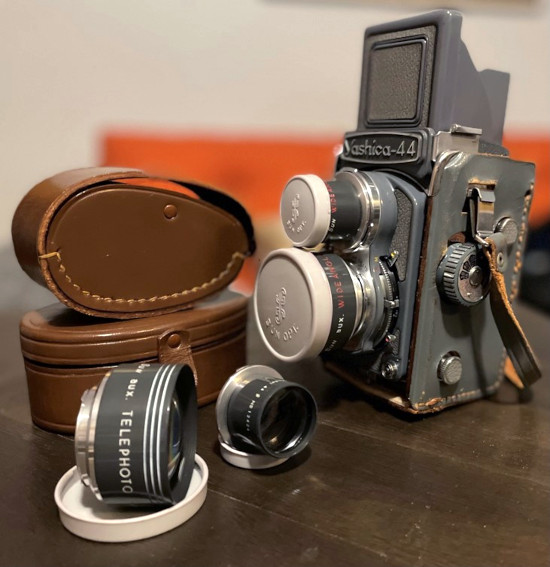
(Image courtesy of Frank Wylie)
Hand Grips (Flash Handles)
For some reason, I always think of these as flash handles but Yashica marketed them as “grips” and the box for 66 cameras is marked “Hand (6x6) Grip”. The versions for both 44 and 66 cameras look identical except for size. Both are light grey. They screw into the tripod socket, provide a grip for the left hand and have an accessory shoe on top for mounting a flashgun. Below the accessory shoe, they have “Yashica-44” or “Yashica-66” badges respectively. They are both from a similar period. The first reference I have seen to them is in a Yashica brochure from about 1959. They also appear in the 1962 Montgomery Ward catalogue and the 66 version was still referred to in the Yashica Mat-124 (released 1968) user manual. Note that crank wind 66 models until the Yashica 24 and the first of the Yashica 44s did not have accessory shoes fitted and is probably the reason that the grips were developed. Here is one attached to a rare “Golden Brown” Yashica 44:
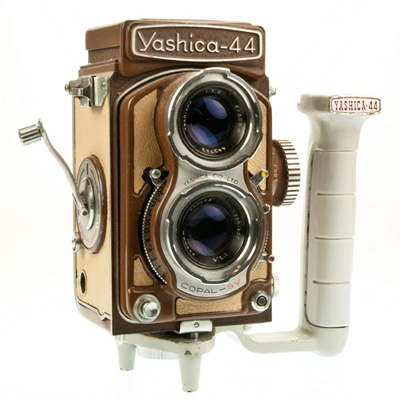
(Image courtesy of Tom Heckhaus)
Self-timers
The Yashicaflex A (A-I and A-II) and AS (AS-I and AS-II) user manuals (1954) refer to using an accessory self-timer in the cable release socket (see immediately below this section). The earlier Pigeonflex, Yashima Flex and Yashica Flex B and more upmarket models had built in self-timers as part of their shutter mechanisms and of the later models, only the Yashica Rookie, Yashica A, Yashica 44A and Yashica E missed out. So far I have identified five separate types of accessory self-timer either used in Yashica documentation and/or Yashica branded. The one depicted in the Yashicaflex A and AS user manuals is the first type (left image, note that the aperture and shutter speed scales on the early black trim camera are upside down as it has a Y.S.K. shutter doctored to look like a Copal):

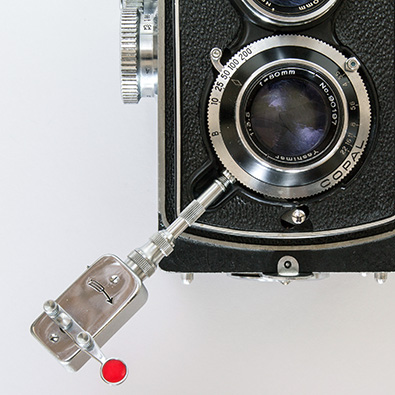
Right image is of a very similar, dare I say identical, “Walz” branded self-timer.
Whether the user manual example is a Yashica branded, or a generic item, is unknown. Almost certainly, this first self-timer was not made by Yashica as the evidence is that the second type, although Yashica branded, was also available under many different brand names.
The example in the user manual is fitted with a long stem to suit the cable release socket on the early Yashicaflex A series cameras but it can be used with any Yashica TLR camera as well as most other types of camera with a socket in the shutter, in the shutter release button or with a removable collar around the shutter button (Leica type, adaptor needed). In the Yashicaflex A and AS user manuals, the self-timer is shown in the set position with the bar with the knobs (for leverage) and red circular indicator at 90⁰ to the body whereas most photos of this type of self-timer show the bar in the released position in line with the body:
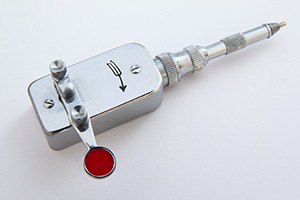
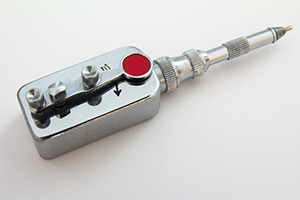
Walz
KK Walz Shōkai was the Japanese company responsible for the Wagoflex and Walz TLRs and many accessories. It is still not clear how much, if any, manufacturing was undertaken in-house or whether Walz was mainly a marketing company. The patent number on the back of the self-timer in the photos is 366274. That number also appears on the instruction sheets of many Kopil self-timers and therefore it seems highly likely that the actual maker may be Kobayashi Seiki Seisakusho (see further below):
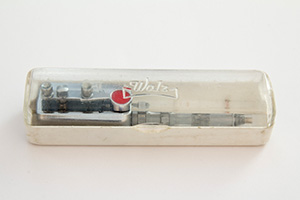
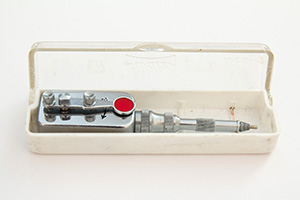
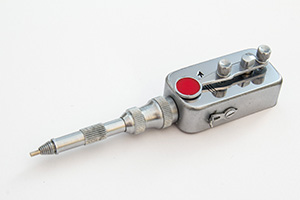
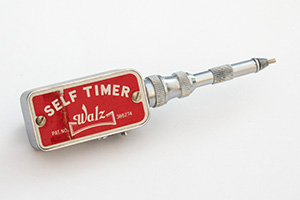
In terms of appearance, the example here and the examples in the early Yashicaflex user manuals are identical, as far as I can tell.
An interesting postscript is that six years later, the user manual for the first Yashica SLR, the Pentamatic, states, “A built-in self-timer was not considered versatile enough for the general needs of the photographer and, therefore, provisions were made for using an accessory self-timer." The accompanying photograph shows a later Walz self-timer:
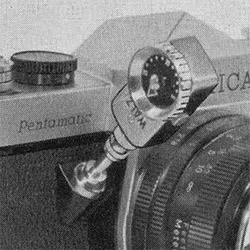
Except for the dial replacing the bar of the example above, the body is very similar and I believe that the patent number on the back is the same. Why not a “Yashica” branded item? Yashica didn't seem too committed to accessory self-timers and appeared to re-brand bought in items when needed (see below). There may have been none in the catalogue at this point in time. Besides, the user manual reference to the self-timer is just a piece of marketing speak to explain why there is no self-timer when someone realised that competitors were including one and raising customer expectations.
Japanese Self-timer Manufacturers
The first Japanese self-timer was the 1933 “King Self Timer”, made by Asanuma Shōkai Co., Ltd., which was a registered copy of the German Autoknips. The design continued to influence post-War models whose development seemed to be more of an evolution of interface and ergonomics than more general innovation.
The two biggest manufacturers of Japanese self-timers were accessory maker Kobayashi Seiki Seisakusho (Kobayashi Precision Works), founded in 1948, using the “Kopil” brand name (Camera-wiki.org) and Suehiro Photo Industry Corporation. Both made self-timers under their own names (Kopil and Suehiro) and also under other names for camera makers and distributors.
Kopil is the most common Japanese brand of 1950s clockwork self-timer found on the internet today. The first model appears to be a copy of the German Auotknips Model IV (as are the Riken and Walz models).
Suehiro located in Nagoya, Tokyo manufactured various self-timers from 1949 onward.
Yashica
The first three of the four Yashica branded types have a large combined winding and setting dial on the front and the “Yashica” name in a Western Serif style. The first of the three is found with a longer stem suitable for Yashicaflex models without shutter button and also with shorter stems - in fact to me it looks like there is both a short stem and an in-between size. Although using a somewhat similar font, this timer has more rounded lettering than later types. A long stem example is pictured below, including fitted to a Yashicaflex AS-II. There maybe another variation with no stem at all, just a Leica nipple at the end of the knurled grip. All the other versions of the first Yashica type come in clear top plastic boxes with the bottom half in a solid red, this one has a bottom half in green.
Below is the model I believe is the first Yashica branded type and perhaps the only Yashica type with a stem suitable for the early Yashicaflex A series cable release cameras:
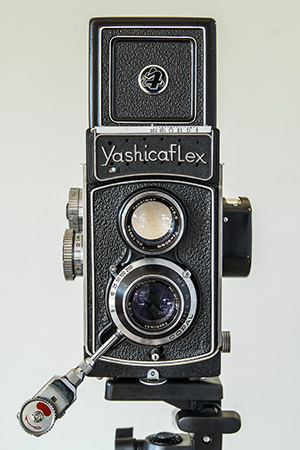
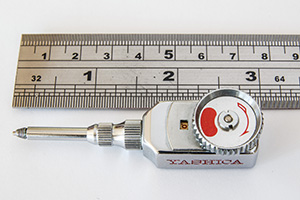
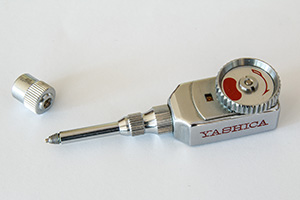
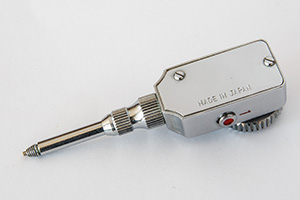
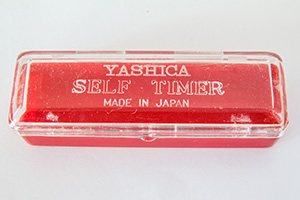
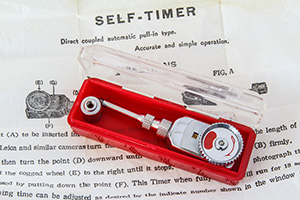
There is an included adaptor for using with other cameras without cable release socket. There is no branding or Yashica reference in the instructions with only “Leica and similar” cameras referred to in connection with the adaptor. This is a strong hint that the self-timer is a generic item bought in by Yashima/Yashica and re-branded.
(Click on image for larger view)
Below is a photo of the same type with short stem and without any identifying marks (photos of short stem types usually show the stem and its knurled grip screwed back against the larger knurled retaining nut, as with the longer shaft above):
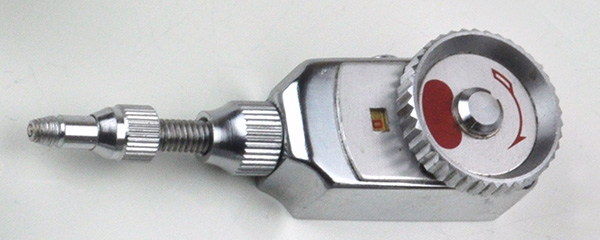
(Image courtesy of Göran Årelind)
I have also found fourteen with otherwise identical bodies and dial with the brand names “Accura”, “Arrow”, “Dia-mond” (by Kashimura, Ltd - the box is marked “Dia”), “Miida”, “Pyramid”, “Suehiro”, “Ultima” and “UN” (complete with a world logo) marked on the back and “Commet”, “Escot”, “Etsumi”, “Juplen”, “Kinegon_T” and “Telesar” on the side. According to Camera-wiki.org, the “Accura” brand was used by an unknown distributer for a large range of mainly Japanese made accessories. One of the Accura examples, the Escot and the Telesar have similar plastic boxes to the Yashica except there is no brand name, although “Self Timer” and “Made in Japan” are identical, and the bottom halves are green instead of red for most Yashica examples. The Dia-mond box is the same except it is marked “Dia” and has the company name. The Escot has identical instructions to the Yashica, however, the Accura instructions are more comprehensive and actually make reference to the “Accura” brand. The Etsumi has the same case except the bottom half is cream. These cases seem shorter than the Yashica item above to match the shorter stems. Both the Juplen and Kinegon_T have long stems like the Yashica, appear to have identical instructions to the Yashica example above and have the same case except the bottom half is green and like the Accura and others, there is no brand marked on the Kinegon_T lid but there is on the Juplen lid. The Suehiro was supplied in a leather pouch.
Most of the the branded items have “Made in Japan”, or in one case just “Japan”, marked on the back but at least one of the unbranded examples has nothing. The only way that any of these physically differ from the “Yashica” item above is that some have a short length stem. There are also what I presume to be four later types with identical bodies except that aperture window is inside the dial and three have a black dial rim. One of the three with black dial rim is in packaging which says “Kalt Corporation”. Another of these has a black body but otherwise it is the same. It has the same instructions as the “Yashica” shown above except for a modified paragraph 4. There are another three with the same body castings and identical release switches but without the top cover plate and each with different dial arrangements. Two have the brand name of a US importer and distributer; one is “Bower” (short stem) and the other “Kalimar” (long stem). The case construction appears to be the same as the others. The top of the Bower case (bottom half, green) is not visible but the Kalimar case (bottom half red) is heavily branded and unlike the others, there is no “Made in Japan”, although “Japan” appears on the bottom of the self-timer. The Kalimar instructions are also heavily branded and different to the others. The third one is branded “Alpex” which may be a brand name used by US distributer Allied Impex Corporation, later to become well known for the Soligor brand. This one has a branded case and although unlike the others in that it has a solid yellow lid, the case design and construction is the same.
According to the German Autoknips site, the Yashica and all the other brands of the type (it lists many more than I have found) were made by Suehiro.
The next two types of Yashica self-timer have the more cramped style of lettering first found on 1958 cameras. One has “Yashica” inside the dial with time marked from 5 to 20 seconds without a separate window and a release button on the top or end face which has quite rounded shoulders, somewhat similar to the Kopil Model 2. The third one, of similar style but clearly different body, has the name below the dial and has “Movie” in place of “Yashica” inside the dial. It was supplied with a grey plastic pouch, with “Yashica” embossed, in a style similar to those used for many flashguns and other accessories in the 1960s. I have seen the last two with short stems only. Whilst all three Yashica branded examples plus the early type in the user manuals are of similar size and share some similar characteristics, there are no obvious features which suggest that they are related to each other.
The fourth Yashica branded type was specifically branded and marketed for the Yashica Ataron Electro sub-miniature (Minox type) camera released in 1970. It has a different connector than the universal type and was updated with new textured black finish and more modern dial graphics to match the Ataron Electro livery and was supplied in a matching black cardboard box.
Using Cable Release
Early Yashicaflex A series cameras, models A-I, A-II, AS-I and AS-II, and the Yashica 12 and Yashica Mat-124, 124G and 124B have built-in provision for using a standard cable release. All other models have the early Leica style plain press button shutter release with a removable collar around the base. With that unscrewed, an adaptor for the cable release can be mounted. This sits over the shutter button and is commonly referred to as the “Leica nipple”. One was included with the Yashica branded self-timer above and below is a generic type from the collection of Tom Heckhaus:
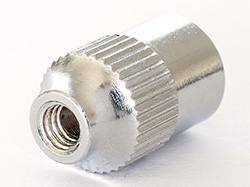
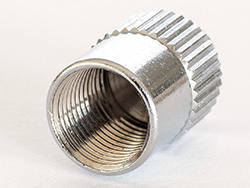
At the time, it was possible to buy release cables with the adaptor attached. These were called “overlap-type” by Yashica:
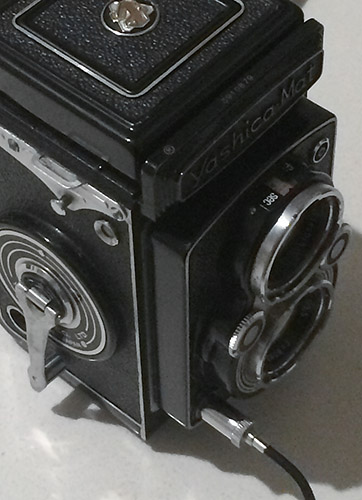 (Images courtesy of correspondent Tim J.)
(Images courtesy of correspondent Tim J.)
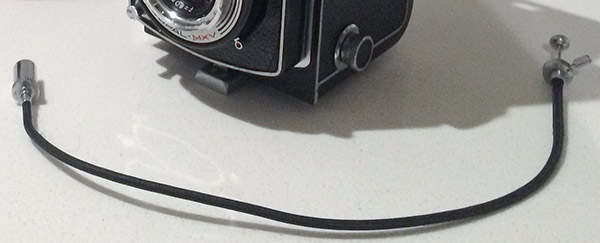
This example is unbranded, most probably a generic type. It has a screw in lock (extreme right of photo) to enable leaving the shutter open on Bulb for longer time exposures. To fit, first unscrew the trim ring around the shutter release (left image). Yashica calls this the “Shutter Release Ring” (early Yashica-Mat user manual):

 (Right document scan courtesy of Chris Whelan)
(Right document scan courtesy of Chris Whelan)
On the right is a similar cable featured in the Yashica Photography user manual for the 1957 Yashicaflex B (new model). It is unknown whether it is Yashica branded and/or made. Below is the only example of a confirmed Yashica branded one that I have seen - this one has a removable Leica nipple, therefore probably originating from a time that 35 mm cameras with their screw-in shutter buttons were already in production:
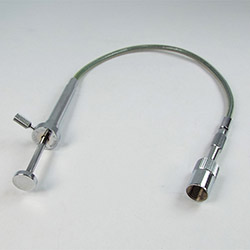
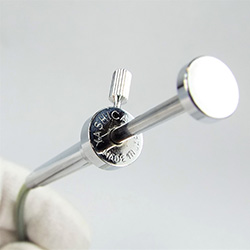 (Images courtesy of Chris Whelan)
(Images courtesy of Chris Whelan)
Accessories Identified in User Manuals etc
1954
(Click on image for larger view)
This page is from the Yashicaflex A user manual for models A-I and A-II released in late 1954. The featured camera still has the earliest trim and Y.S.K. shutter. As noted at the top of this page, it is very unlikely that any of these items are Yashica branded. I have not seen any Yashica branded square shaped push-on lens hoods or flashguns of the type depicted come up for sale (the lens hood in the manual is likely to be an “ACE 32”). There were Yashica branded self-timers which screwed into the cable release sockets of the Yashicaflex A series but these seem to be from later (see “Self-timers” in “Dedicated Yashica TLR Accessories” above). I doubt that at least the one depicted in the manual and the first of four known branded types were manufactured by Yashica and probably none were.
Looking at sales brochures, user manuals and now my copies of the flashgun, I believe that the “C” cell powered flashgun is almost certainly a Minicam Synchron Junior unit manufactured by Minicam Research Corporation of Japan (see “Minicam” in “Accessories, Other”). Close up detail of the bracket clamp and reflector mount in the Yashicaflex AS manual confirm these to be identical to the Minicam unit.

(Document image courtesy of Tom Heckhaus)
1955-1956
The images and text below are from the combined “Yashicaflex Directions for Use Models A & C”. The cover on one example has a pen and ink notation, “Purchased Feb 1957 Okinawa”. The Directions cover a number of models including the Yashicaflex Model S, later versions of the A series cameras noted above and the Yashicaflex C released in 1955.

(Document image courtesy of Tom Heckhaus)
The first camera has a “pocket” bulb flashgun with folding reflector mounted horizontally to the accessory shoe. In terms of overall shape and layout, cut-away at top corner for plug in sync cord, placement of bulb ejector and test button, size and placement of the exposure table and the design of the joining straps on the reflector back edge, it is identical, as far as I can tell, in style to an earlier Walz model (Walz was a Japanese camera and accessories maker or distributer in the 1950s - Camera-wiki.org) but there is no way of identifying the actual brand for certain.
The flash fitted to the Yashicaflex C on the right has a fixed reflector. From my research into Nicca flashguns, it is certainly a “West Miracle Power B-C Westo-Mat” made by West Electric Co., Ltd. of Osaka, Japan. There is more in Nicca's Flashgun Origins including what is known about West and comparison of the flash here with Nicca and Nikon models.
Both flashes also appear in the Japanese language Yashima “Yashicaflex Photography”. The first printing was 5 August 1955, the second printing was 10 August 1955 and the third printing (reprint) was 20 October 1955 (interestingly, the series of model A-II pictures in the two documents are all different to each other but at the same time, very similar using cameras from a similar trim point in time, however, for the English language document, the model, mostly hands shown, is female whilst for the Japanese document, the model is male, even though again it is mostly hands that are visible):
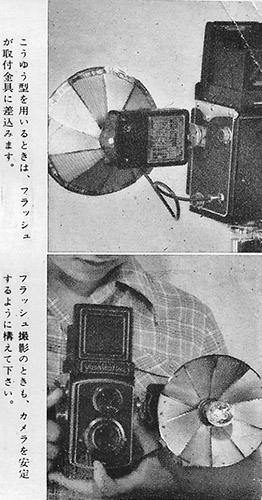
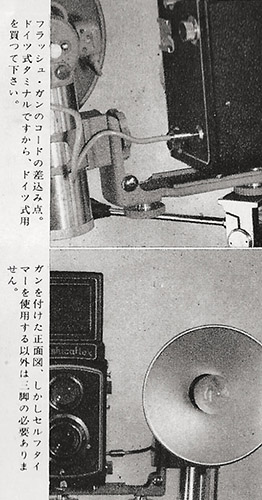
(Document images courtesy of Chris Whelan)
No other accessories are depicted in the English language document except showing the fitting of a cable release for long exposures. For the Yashicaflex C, the manual states “Fitting Accessories Available.” This could be the Bay 1 lens hood and pouch first clearly identified in a December 1956 Japanese brochure, see “Overview” above. The Japanese document adds what appears to be same self-timer as in the Yashicaflex A manual and a new type circular lens hood (could be another ACE item, see Lens Hoods):
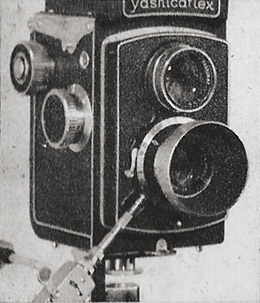 (Document image courtesy of Chris Whelan)
(Document image courtesy of Chris Whelan)
Yashicaflex Photography also includes details and prices of two Sekonic hand held exposure meters confirming the close relationship between the two companies at this stage, but a divorce was coming:
 (Document image courtesy of Chris Whelan)
(Document image courtesy of Chris Whelan)
The smaller meter on the right is the L-7, still in the “Baby” series (as was the earlier CB-1 fitted to the Yashicaflex model S and AS-II). The other is, I believe, the Leader L-6.
1956-1957
The second version (and probably first also) Yashica LM user manual, with film counter reset button still, shows the same type of “C” cell powered flashgun with non-folding reflector as for “1954” above (the slightly later third version user manual without the reset button doesn't use a model and the flashgun is the similar but larger type described further below):
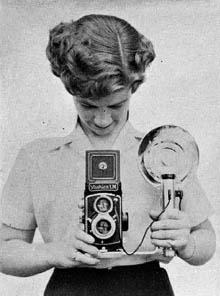
From the same period (in fact same day - same model in the same outfit with the same hair), the similar Yashica C second type user manual (with reset button still) instead shows a dish shaped reflector attached to a straight bracket affixed to the camera's tripod mount (i.e., no riser) with a coiled cord running back to a power pack on a shoulder strap, clearly an early electronic flash unit.
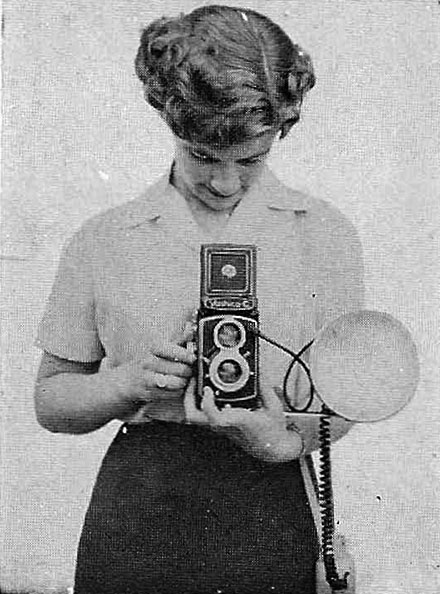
(Document image courtesy of Göran Årelind)
In both the earliest Yashica A manual (with airline stewardess on cover) and the second version matching the LM and C manuals referred to above, the same model (still with identical hair and therefore almost certainly on the same day) appears with the electronic flash as used in the C manual and the “C” cell powered flashgun from the LM manual is shown by itself, i.e., the most basic camera model is shown with both flash options whilst the other two are shown with an example of one type only.
For the first time, all three camera's manuals refer to “electronic flash”. A later Yashica A manual has both a photo of the camera by itself with a bulb flash attached, similar to but not the same as that in the first photo above, and a line drawing of the woman with the electronic flash and power pack. The bulb flash is almost certainly the larger Minicam Synchron Master which uses “D” cells (also featured in the third version of the Yashica LM manual). Both the line drawing and the same flashgun reappear in the Yashica Auto user manual of 1959. Yashica-Mat user manuals mention flash use but as far as I am aware, only the very earliest with “Yashicamat” on the cover actually displays a photo with flash attached. It is the same type as in the later Yashica A and Yashica Auto user manuals.
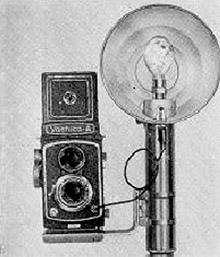
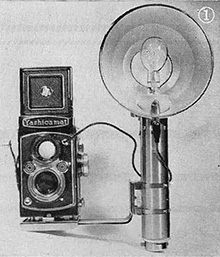
Except for the Yashica E user manual, the above photo and drawings of the model with shoulder pack electronic flash are the last time that an electronic flash was depicted until around 1970, although they continued to be mentioned in the text of some manuals but not all. In 1956, portable units were probably new and exciting but the reality was that they were cumbersome and expensive and limited to specialised professional use. Performance was probably pretty uninspiring as well.
One of the earliest self-contained types, the “potato masher” Heiland/ Honeywell/ Rollei (Rollei from 1967) Futuramic Strobonar (64 series) had first appeared in commonly recognisable form as early as 1958 (contrary to some net commentary, Rollei initially adopted Heiland/Honeywell technology via US Rollei importer Honeywell, not the other way around) but at first, Rollei also continued into the early 1960s with bulb flash units. Strobonars began appearing in US Pentax user manuals (Heiland/ Honeywell, not Asahi) from around 1960 but, Asahi Pentax avoided depicting flashguns even after they had released their own “Super-Lite”. The user manual for the high end 1962 Nikon F2 Photomic shows a basic Nikon BC-7 folding reflector bulb flashgun. So it is not so surprising to discover that Yashica user manuals for TLRs, 35 mm rangefinders and SLRs mostly don't feature electronic flash in the 1960s even though Yashica branded models were appearing in brochures from at least 1962.
The Japanese language “Yashicaflex Photography” user manual for the 1957 Yashicaflex B (new model) features both the Minicam Synchron Master and an unknown folding reflector type and the camera is fitted with a lens hood, something not featured in pictures in English language user manuals from the period:
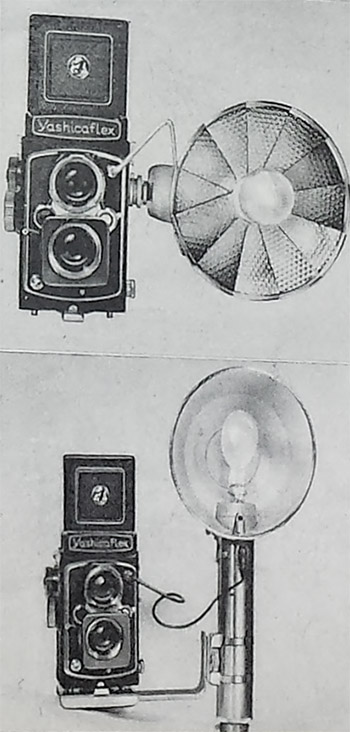 (Document image courtesy of Chris Whelan)
(Document image courtesy of Chris Whelan)
However, from the 1956 Yashica C & LM user manuals onward, there is reference to the availability of “sunshades” and “complete range of filters and supplementary lenses” to fit the Bay 1 mount. No particular branding is mentioned, only to see your camera dealer for assistance. The Yashica A user manual indicates that the same range of accessories was available for the 32 mm push-on mount.
The Japanese manual also replaces the pair of Sekonic exposure meters featured in the 1955 edition with a Walz Coronet B (complete with removable low light booster cell attached) and Walz Norwood Super Director incident meter (made under license to the US patent holder):


(Document images courtesy of Chris Whelan)
In the 1960s, Yashica would move on to Showa Koden Co., Ltd., for at least two of its own re-branded handheld meters.
The manual also features the locking overlap-type cable release identified in Using Cable Release.
1958-1965
The first Yashica D and 635 manuals (models introduced in 1958) show a bulb flashgun with folding reflector mounted horizontally to the accessory shoe.
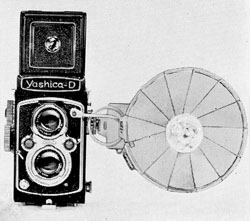
Branding is not mentioned or discernible. As noted above, the 1959 English language Yashica Auto manual features both a line drawing of the earlier shoulder pack electronic flash and the Minicam Synchron Master bulb unit. The Japanese Yashica A III user manual from the same period also features the Synchron Master plus a folding reflector type similar to the one on the Yashica D but with a body with chamfered corners. Other English language manuals in this period don't seem to have photos of flashguns until the Yashica 24 appeared (1965). One exception is the Yashica E manual from 1964 which actually shows an electronic flash attached, the “Yashica Quick-Lite Pro-40” (see the Swift & Bleakley Pty. Ltd. brochure under “Flashguns” below). The commonly available Yashica Mat-EM manual is multi-lingual and somewhat truncated in its detail but its Japanese language counterpart is full featured and also features the same electronic flash.
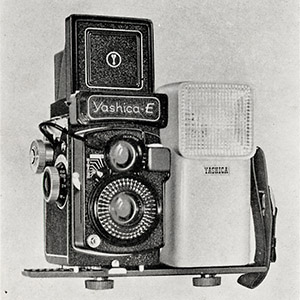

(Right image scan courtesy of Chris Whelan)
The user manual references to lens hoods, filters and auxiliary lenses in this period remained similar to the generic statements of the mid to late 1950s manuals. The Yashica E is again an exception with a black rimmed, “Yashica” branded, 52 mm screw-in filter shown and the Japanese Yashica Mat-EM manual shows a “Yashica” branded silver Bay 1 filter and typical Yashica lens hood.
This is an extract from a Yashica US brochure covering the full range of products and originating from about 1959 (Yashica 44 and Yashica 44A shown together). Included are accessories for both 44 and 66 TLRs:

The surprising inclusion is a close-up auxiliary lens set in slip-on fitting. However, as the brochure includes the full TLR range that seemed to be on sale as well as the 35 mm range, movie cameras and equipment and even a Yashica transistor radio, it is odd not to see filters mentioned, nor auxiliary wide angle and telephoto lens sets, nor flashguns, nor tripods which became common in subsequent brochures from 1962 on. It makes me wonder whether those things were available with Yashica branding yet. On another page, there is an exposure meter (see Exposure Meters).
The accessories page of a brochure from around 1964 by UK importer Photax lists more items but still leaves gaps, including auxiliary wide angle and telephoto lens sets, but as it covers TLRs only, its omission of items such as tripods, flash units and exposure meters is perhaps not so surprising:
(Brochure provided by Göran Årelind)
(Click on image for larger view)
1965-1970
Although using electronic flash is mentioned, the Yashica 24 manual has a photo of a flashbulb type unit with small, non-folding circular reflector integrated into a 1960's style TV screen shaped housing sitting on top of a “Yashica” branded flash handle. The flash unit is described in other documentation as “AG Flash Gun” but its instructions and box call it “Yashica-Lite AG Flash Gun”:
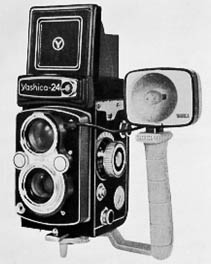
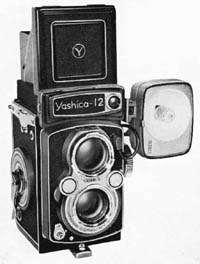
The Yashica 12 manual has the same gun mounted sideways directly to the accessory shoe (note that some examples of the Yashica 24 in the user manual do not have an accessory shoe - all that I have found, do). The availability of a bracket is mentioned.
The Yashica Mat-124 user manual still displays a bulb type flashgun, this time with a circular housing the same size as the non-folding reflector. Other documentation names this as the “AG-D” flashgun. It is mounted directly to the accessory shoe although, the bracket is again mentioned. In case that there is any thought that these were TLR specific accessories, I have found an accessories brochure on the net which has both the AG and AG-D flashguns, as well as the electronic flash Quick-Lite Pro-100 below, attached to 35 mm rangefinder cameras. The AG-D model also has a hot shoe (not used on TLRs) and appears in the Yashica TL-Super SLR user manual, is called the “Yashica-Lite AG-D” in the Yashica SLR System Accessories booklet featuring the Yashica TL-Super and appears in the Yashica Electro 35 rangefinder user manual.
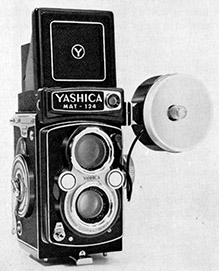
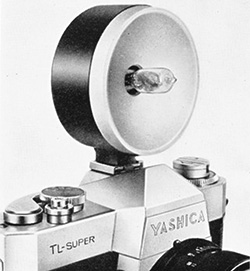
However, the Yashica TLR brochure further below does show the three units plus the smaller “Yashica Quick-Lite Pro-50” electronic flashgun attached to TLRs.
The last Yashica D manual, with “66” on the cover, from around 1970 (the example camera has a black locking knob), has a photo of a pro style electronic flashgun with handle attached to a tripod mount bracket called the “Yashica Quick-Lite Pro-100”.
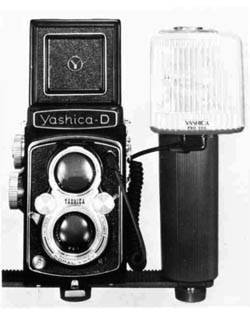
The user manual references to lens hoods, filters and auxiliary lenses remained similar to the generic statements of the mid to late 1950s manuals until the Yashica 12 of 1967. This makes specific reference to “Yashica” filters Y2, O2 and UV for B&W photography and to an “EXCLUSIVE LENS HOOD (with leather case)” and shows a silver rimmed “Yashica” labelled filter being fitted. The Yashica Mat-124 manual has the same references and a picture of a silver rimmed filter and a square hood with “Yashica” in the oval logo (which on cameras, only appeared from about 1955 to 1958, perhaps a little longer on accessories - old photo?).
Göran Årelind has provided a copy of a Yashica TLR brochure for the Yashica Mat124, Yashica-Mat, Yashica 635, Yashica D and various accessories:
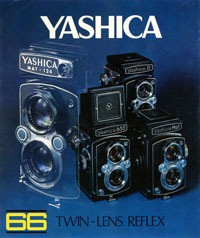 (Click on cover to view full brochure as PDF)
(Click on cover to view full brochure as PDF)
The accessories page is reproduced below:

Note that only the “Filters & ....” panel depicts dedicated TLR accessories.
1970-1983
Both the first user manual for the Yashica Mat-124G with “66” on the cover (similar to the Yashica Mat-124 and Yashica 24 and 12 manuals) and the first of the later style manuals with the photo of the camera on front, show the “Yashica Quick-Lite Pro-100” fitted:
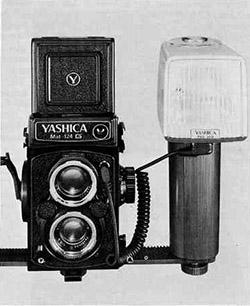
Both manuals list available filters as UV, ND2, Y2, O2, R1, and G1 for B&W film and 1A, 80B, 81B, 82A and 85 for colour film. The first manual shows a single silver rimmed “Yashica” branded filter only whilst the second one shows both silver and black rimmed examples.
The square hood in both manuals has the heavy serif script style of cameras from 1958 until the release of the Yashica 24 in 1965 but continued on the Yashica 635, D and Mat until their demise in the early 1970s.

Detail is from the second manual.
There is a Yashica brochure which shows the Yashica Mat-124G and the last versions of the Yashica-Mat, Yashica D and Yashica 635 together. Apart from the 635 35 mm kit, the only accessories shown are one of the wide/tele lens kits and one of the close-up lens kits (all black). The leather cases for these accessory items are black.
1983-1986
The flash unit in the Yashica Mat-124G user manual with Kyocera Corporation branding on the back cover, is the Contax RTF540, also featured in the brochure further below:
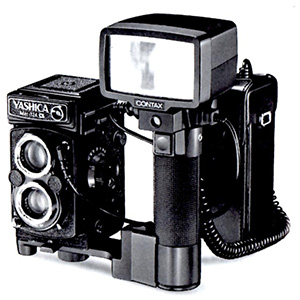
This unit was actually released in 1978 and made for Yashica by National (part of what these days is Panasonic Corporation).
The Accessories page now only mentions UV, Y2 and O2 filters for B&W film without reference to colour. Three black rimmed filters are shown and the lens hood has “Yashica” in the modern sans serif style. is

I have a copy of a 6 page brochure for the Yashica Mat-124G with Kyocera address on the back which puts it in the 1983 (year of Kyocera acquisition) to 1986 (end of production) period. I would say close to 1983 because I also have a downloaded version of the same brochure with more prominent Kyocera branding. Accessories shown in order are:
- Large “Contax” branded model RTF540 handle type pro flash unit mounted to the base of the camera (borrowed from Yashica's “Contax” line of SLRs).
- Four small “Yashica” branded electronic flash units, no doubt designed for 35mm cameras. Three of them require a hot shoe adaptor for the Mat-124G.
- Close-up lens sets Nos. 1 and 2 (similar to the black sets above).
- Cable release.
- Lens hood.
- Four Bay 1 filters with black rims: red, yellow and presumably UV and 1A (skylight).
(Click on pages for larger view)
Pages 5 and 6 shown. Full PDF version is here.
Noticeably absent are the wide angle and telephoto auxiliary lens sets. Perhaps these were discontinued already?
.jpg)

.jpg)
.jpg)
.jpg)